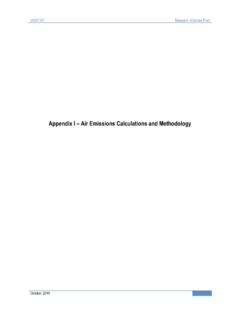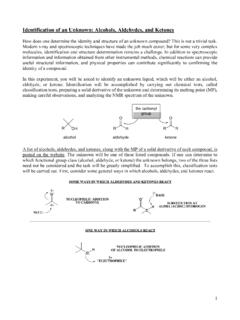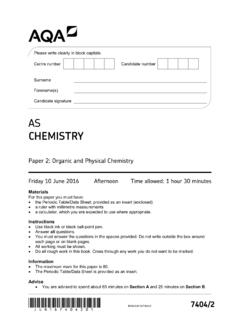Transcription of Nanotechnology: Applications, techniques, approaches, & the
1 Nanotechnology: Applications, techniques, approaches, & the advancement in toxicology and environmental impact ofengineered nanomaterials1 MedDocs eBooksPublished Online: Jun 12, 2019eBook: Importance & Applications of NanotechnologyPublisher: MedDocs Publishers LLCO nline edition: : Zaib S (2019). This chapter is distributed under the terms of Creative Commons Attribution International LicenseCorresponding Author: Sumera ZaibCentre for Advanced Drug Research, COMSATS Uni-versity Islamabad, Abbottabad Campus, Abbottabad-22060, Pakistan Email: & Applications of NanotechnologySumera Zaib*; Jamshed IqbalCentre for Advanced Drug Research, COMSATS University Islamabad, Abbottabad Campus, Abbottabad-22060, PakistanIntroductionNanoscience refers to the handling of materials, systems and devices at atomic, molecular and macromolecular level, where-as, nanotechnology is the cluster of techniques involved in de-sign, synthesis, characterization and application of structures, materials, devices and systems by manipulating shape and size at nanometer scale.
2 At nanometer level, individual molecules and interaction between them becomes important in compari-son with the macroscopic properties of the material or device. Control at nanometer scale and manipulation of fundamental molecular structure permits to regulate the bulk macroscopic chemical and physical properties of the material and device [1]. The scale of dimensions is frequently <100 nm. The idea of nano-science is credited to physicist Richard Feynman in 1959, where he delivered a lecture at American Physical Society There s plenty of room at the bottom - an invitation to enter a new field of physics and he explored the ideas and benefits of manufacturing devices, and things on the very small scale. He anticipated the ideas that might be utilized to produce large-scale integrated circuits, gene sequencing, reading DNA mol-ecules, and electron microscopy for writing enormous amounts of information in very slight bits.
3 Many of his predictions are now well-established techniques in nanotechnology, although, he didn t coin the term nanotechnology [2].Norio Taniguchi in 1974 used the term nanotechnology, while describing how the dimensional accuracy has improved with elapsing time. He was the first one to study development and advancements in machine technologies over three decades from 1940s to 1970s. He had foreseen the development of dimensional accuracies better than 100 nm by the era of late 1980s. He employed the term nanotechnology for these future developments [3]. Initially, physicists and engineers were the pioneers of nanotechnology. They developed nanotechnology by realizing the ideas of Feynman. He predicted the possibili-ties of developing technologies that might take, shuffle and re-arrange an atom to make new chemical analogue.
4 In 1981, two scientists at Zurich, developed scanning probe microscope and won Noble prize in 1986. In this microscope, a sharp metal head MedDocs eBooks2 Importance & Applications of Nanotechnologyscans above the surface to visualize these atoms on surface. Ei-gler and his group explored the basics of physical and quantum mechanical phenomena using the same technique. In 1989, Ei-gler and his co-workers used the same technique to spell IBM on the surface of xenon atoms at temperature close to absolute zero [4]. Gimzewski worked on extreme nanotechnology, where he pushed single molecules around surfaces at room tempera-ture using similar technology [5].Advancement in nanotechnologyWith the development in areas of materials science, chem-istry and engineering over the previous few eras nanotechnol-ogy has remained exploited in all fields where insignificant size plays crucial part in determining fundamental properties.
5 They are being used from physics, engineering, and chemistry to biologicals and medicine. Nanoparticles of cadmium telluride are employed in the labelling of biological molecules with pre-cision. Nanoparticles of titanium dioxide effectively block UV radiation and they are the main component of sun screens. In 1985, carbon-60 molecule was exposed by Harry Kroto, Richard Smalley and Robert Curl and they won the Nobel Prize for their work in 1996. In 1991, carbon nanotubes were discovered by Iijima. A type of nanotechnology Bottom-up nanotechnology involves the self-assembling traits of biological systems, such as DNA molecules which control the organization and structure of carbon nanotubes [6]. Nanotechnology in food processingNontechnology has been implicated in food industry for the past decades to improve quality, taste and texture of foods, and to prevent them from pathogen infestations.
6 Nanotech-nology is employed to increase the shelf-life and improve the storage of food materials by preventing microbial infestations [7]. Nano-carriers are now used as delivery systems for food additives without disturbing the basic morphology of food. In nutraceuticals, an ideal delivery system (nano-carriers) should distribute the active compound precisely at specific rate on tar-get place. Nanotechnology has become an integral part of food processing and food packaging with the advent in development of nano-polymers. Nano-sensors have been developed for the apprehension of contaminants, pathogens and toxic materials in food [8].Figure 1: Nanotechnology in food processing and food packing [9].In food industry and medicine, encapsulation of nanopar-ticles give better release and efficiency in addition to masking the odour and bitter taste.
7 It controls the interactions between ingredients and the food matrix with controlled delivery of the active agents and its accessibility at specific rate [10]. Nano-encapsulation protects food ingredients from heat, moisture and degradation during various phases of processing, manufac-turing and storage, it also increases compatibility of different compounds in the system [11]. Different polymer-based encap-sulation and delivery systems have been developed for better bioavailability, conservancy of the active food components and aptitude to infiltrate deeply into tissues. It allows effectual dis-tribution of the active component towards target point in body [12]. By nanotechnology food products have been improved in terms of texture, appearance, taste, nutritional value, and their shelf-life.
8 Nanotechnology is responsible for significant modifi-cations in food products as they improve the quality and en-hance the taste of food. Nano-encapsulation has been broadly used for the release of desired flavour and its retention to de-liver culinary balance. Encapsulation of cyanidin-3-O-glucoside in the inner cavity of recombinant soybean seed has resulted in improved thermal and photo stability [13]. Encapsulation of rutin with ferritin enhanced the solubility, and stability against heat and UV radiations [14]. Lipid-soluble bioactive compounds are formulated in nano-emulsions using natural food ingredi-ents to enhance water-dispersion and bioavailability [15]. As compared with conventional methods nanoparticles improve the bioavailability of nutraceuticals.
9 Silicon dioxide (SiO2) is used as colouring agent in food items. SiO2 nanoparticles are used as the carriers of flavours in food products [16].Macromolecules in the body essential for cellular haemosta-sis such as lipids, vitamins, proteins and carbohydrates require optimum pH for their activity. In addition, they are sensitive to low pH environment. Encapsulation of these compounds helps them to resist acidic environment. Moreover, it allows them to integrate readily in food products. Nanoparticles-based capsules are formulated for significant benefits over conven-tional capsules [17]. Different techniques are employed in the process of nano-encapsulation to effectively deliver nutrients, proteins, and antioxidants and the other active compounds.
10 Polymer based nanoparticles are appropriate for encapsulation of bioactive compounds to protect and transport the targeted delivery [18]. Furthermore, nano-encapsulation of bioactive components extend the shelf life of food materials either via reducing degradation process otherwise by preventing depri-vation unless the product is transported towards target site. Nano-coatings are done on various food materials and they are found to be effective barrier against moisture and gas exchange. These coatings are also responsible for specific colour and fla-vours of food product. It also effectively delivers enzymes and antioxidants, hence increasing shelf-life of manufactured foods once the seal is opened [19]. Encapsulating functional compo-nents retards the chemical degradation process encapsula-tion of curcumin exhibited condensed antioxidant activity and it was found to be stable to pasteurization and at diverse ionic strengths [20].






